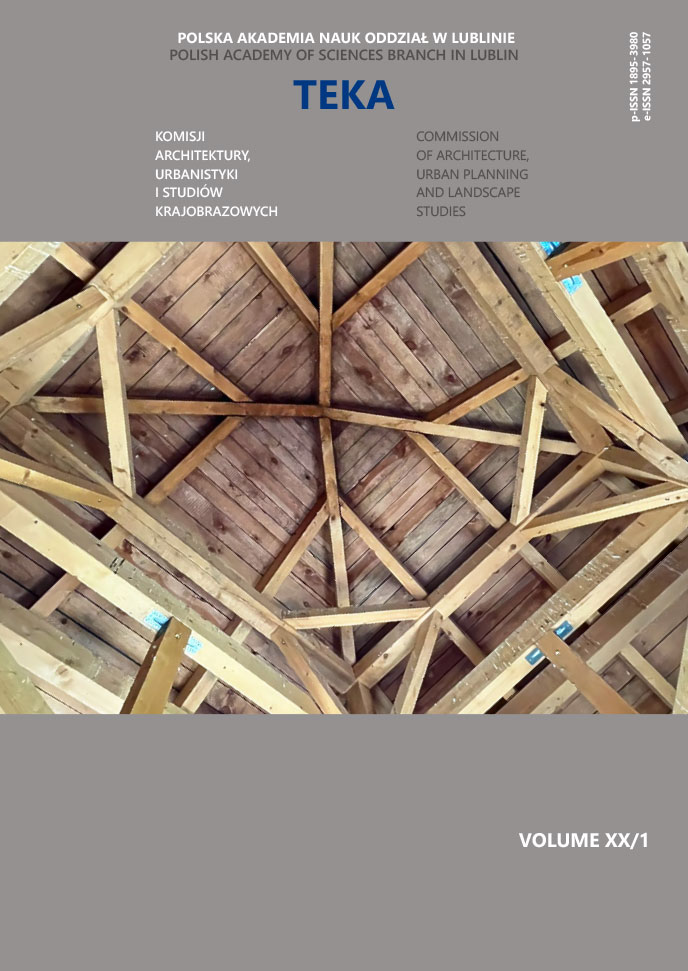Adaptation of Service Premises for Families with Children in the Context of Accessibility and Inclusivity
Article Sidebar
Open full text
Issue Vol. 20 No. 1 (2024)
-
Problems of adapting lecture halls of Lublin University of Technology to modern utility needs
Bartłomiej Kwiatkowski, Kostiantyn Pinkovskyi, Pavlo Lozovskyi7-18
-
Green Revitalization of the NZS Square in Bialystok
Andrzej Tokajuk19-27
-
Formal Constituent Elements of a Dynamic Model of Object Formation
Ihor Yurchenko28-35
-
Degradation of Public Spaces on the Example of Selected Squares and Markets in Wielkopolska
Karol Tomczak, Paweł Szumigała36-49
-
Adaptation of Service Premises for Families with Children in the Context of Accessibility and Inclusivity
Dariia Kryshnivska, Małgorzata Kozak50-59
-
Architecture of Selected Psychiatric Day Centres – a Case Study
Rafał Strojny, Weronika Gospodarek60-68
-
Dendrochronology and Accelerator Mass Spectrometry (AMS) Carbon 14 Dating: A Novel and Potent Combination
Myron O. Stachiw, William A. Flynt69-79
-
Children’s Awareness of People with Disabilities and Their Barriers
Kornelia Szadura, Piotr Gleń80-87
Archives
-
Vol. 20 No. 3
2024-12-27 7
-
Vol. 20 No. 2
2024-12-27 7
-
Vol. 20 No. 1
2024-12-27 8
-
Vol. 19 No. 2
2023-12-29 11
-
Vol. 19 No. 1
2023-12-19 13
-
Vol. 18 No. 4
2022-12-30 5
-
Vol. 18 No. 3
2022-12-27 5
-
Vol. 18 No. 2
2022-12-27 5
-
Vol. 18 No. 1
2022-12-27 4
-
Vol. 17 No. 4
2021-12-30 11
-
Vol. 17 No. 3
2021-12-30 9
-
Vol. 17 No. 2
2021-12-30 8
-
Vol. 17 No. 1
2021-12-30 8
-
Vol. 16 No. 4
2020-12-30 11
-
Vol. 16 No. 3
2020-09-30 10
-
Vol. 16 No. 2
2020-06-30 11
-
Vol. 16 No. 1
2020-03-31 10
Main Article Content
DOI
Authors
Abstract
The arrival of children in a family significantly alters daily life, while public spaces such as service premises often remain inadequately adapted to the new needs of parents and their children. As a result, urban environments become less welcoming and more challenging to navigate, limiting opportunities for free movement and participation in social life. From the perspective of an average user, the absence of a changing table in a shopping centre restroom, a feeding table in a restaurant, or a play corner may seem like minor inconveniences. However, for parents with young children, these are essential infrastructure elements, whose absence contributes to the exclusion of this social group. This article analyses the accessibility and inclusivity of public spaces in terms of their adaptation to the needs of families with children, with particular focus on shopping centres, dining establishments, and cultural buildings. Based on a survey conducted among parents of children aged 0–7 years residing in Lublin, problematic locations and gaps in the existing infrastructure were identified. The research findings were compared with examples of solutions implemented in modern European cities, enabling the formulation of recommendations tailored to the local conditions of Lublin. The implementation of these proposed solutions could significantly enhance the comfort and quality of life for families in the city and support the concept of sustainable development.
Keywords:
References
GUS, “Raport zawierający wstępne wyniki NSP 2021”, stat.gov.pl. Available: https://stat.gov.pl/spisy-powszechne/nsp-2021/nsp-2021-wyniki-wstepne/raport-zawierajacy-wstepne-wyniki-nsp-2021,6,1.html [Accessed: 09 December 2024].
“Building Family-Friendly Communities | Miracle Recreation”, Available: https://www.miracle-recreation.com/blog/building-family-friendly-communities/?lang=can [Accessed: 09 December 2024].
“Inclusive by Design: Laying a Foundation for Diversity in Public Space”, Available: https://www.pps.org/article/inclusive-by-design-laying-a-foundation-for-diversity-in-public-space [Accessed: 09 December 2024].
Lilius J., “Urban space in the everyday lives of mothers and fathers on family leave in Helsinki”, European Urban and Regional Studies, vol. 24, no. 1, (Jan. 2017), pp. 104−118. https://doi.org/10.1177/0969776415619662. DOI: https://doi.org/10.1177/0969776415619662
Mordyński K., “Muzeum, Gość i Przestrzeń Potrzeby Muzealnych Gości a Funkcje i Sposoby Kształtowania Pozaekspozycyjnej Przestrzeni Muzealnej”, Muzealnictwo, vol. 53, (2012), pp. 102−108.
Porębska A.E. et al., “Invisible barriers : excluding accessibility from the field of interest of architecture and urban planning in Poland”, Disability & Society, vol. 36, no. 6, (2021). https://doi.org/10.1080/09687599.2021.1902281. DOI: https://doi.org/10.1080/09687599.2021.1902281
UNICEF, The state of the world’s children.: 2012. UNICEF, 2012. Available: https://digitallibrary.un.org/record/725293.
Ataol Ö. et al., “Towards inclusive urban environments for infants and toddlers: Assessing four urban neighbourhoods in Istanbul with mothers”, Children & Society, vol. 36, no. 6, (2022), pp. 1177−1193. https://doi.org/10.1111/chso.12566. DOI: https://doi.org/10.1111/chso.12566
Hassinger-Das B. et al., “Learning Landscapes: Playing the Way to Learning and Engagement in Public Spaces”, Education Sciences, vol. 8, (May 2018). https://doi.org/10.3390/educsci8020074. DOI: https://doi.org/10.3390/educsci8020074
“New guidelines put accessibility and inclusion at the heart of building design”, Available: https://www.architecture.com/knowledge-and-resources/knowledge-landing-page/new-guidelines-put-accessibility-and-inclusion-at-the-heart-of-building-design [Accessed: 09 December 2024].
Belausteguigoitia J., Inclusive Urbanism, Sustainable Design and Community Engagement: A Holistic Approach. 2019, p. 141. https://doi.org/10.2495/SC190121. DOI: https://doi.org/10.2495/SC190121
Patrick M. and McKinnon I., “Co-creating Inclusive Public Spaces: Learnings from Four Global Case Studies on inclusive Cities”, The Journal of Public Space, vol. 7, no. 2, (Jun. 2022), pp. 93−116. https://doi.org/10.32891/jps.v7i2.1500. DOI: https://doi.org/10.32891/jps.v7i2.1500
Architects H.M.C., “A Space for All Ages: Socially Inclusive Architecture at Work | Ideas”, HMC Architects. Available: https://hmcarchitects.com/news/a-space-for-all-ages-socially-inclusive-architecture-at-work-2019-07-12/ [Accessed: 09 December 2024].
Wysocki M., Dostępna przestrzeń publiczna. Samorząd równych szans. FIRR, 2009. Available: http://ngoteka.pl/handle/item/22.
“Agenda 2030 (rezolucja)”, Available: https://www.un.org.pl/agenda-2030-rezolucja [Accessed: 09 December 2024].
“Portal Gov.pl”, Gov.pl. Available: https://www.gov.pl [Accessed: 09 December 2024].
“Building Better Cities with Young Children and Families”, Van Leer Foundation.
Perez C.C., Invisible Women. 2020. Available: https://www.penguin.co.uk/books/435554/invisible-women-by-perez-caroline-criado/9781784706289.
“Children & Families”, Design Museum Denmark. Available: https://designmuseum.dk/en/besog-os/children-families/ [Accessed: 09 December 2024].
Article Details
Abstract views: 174



